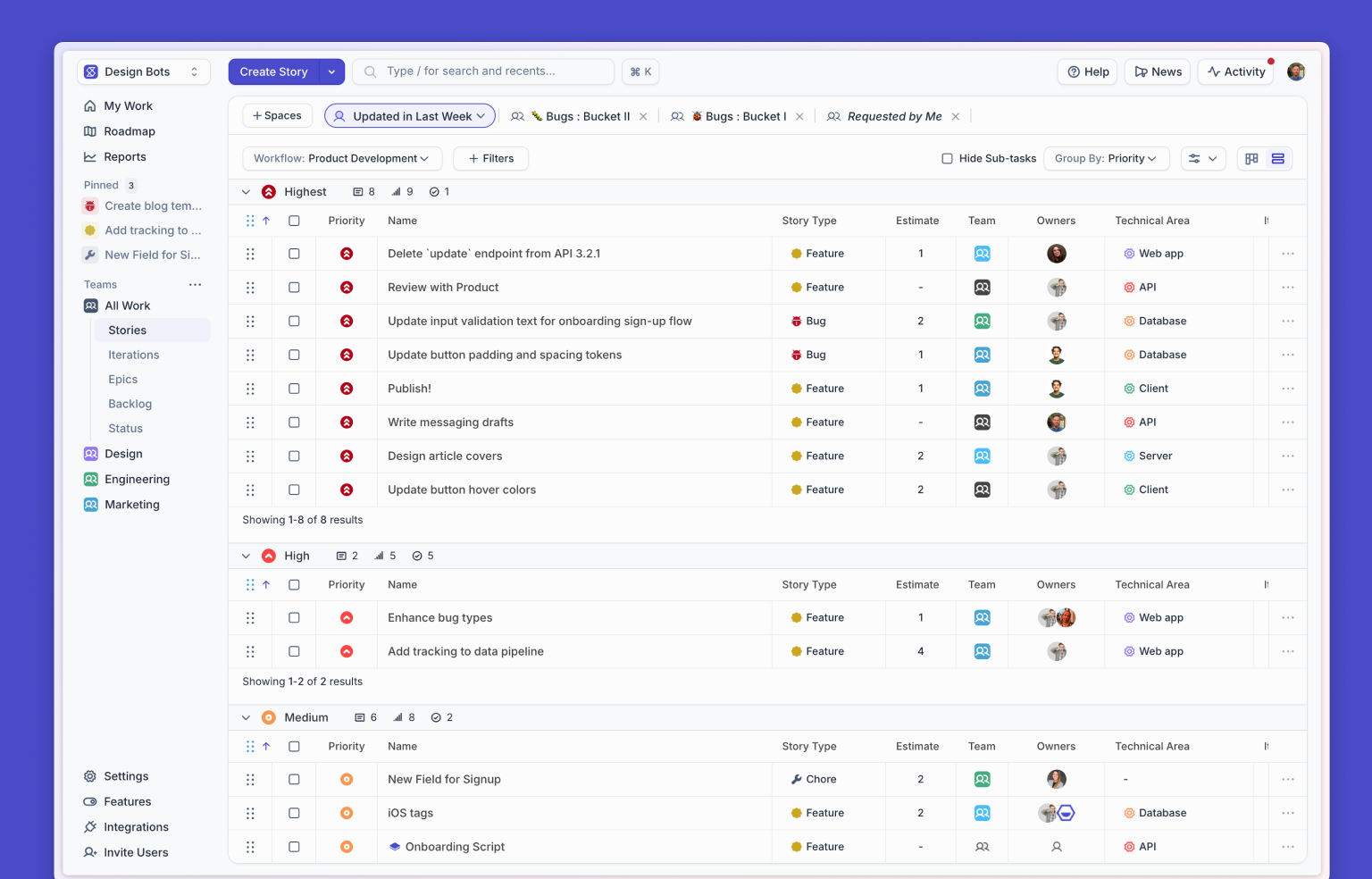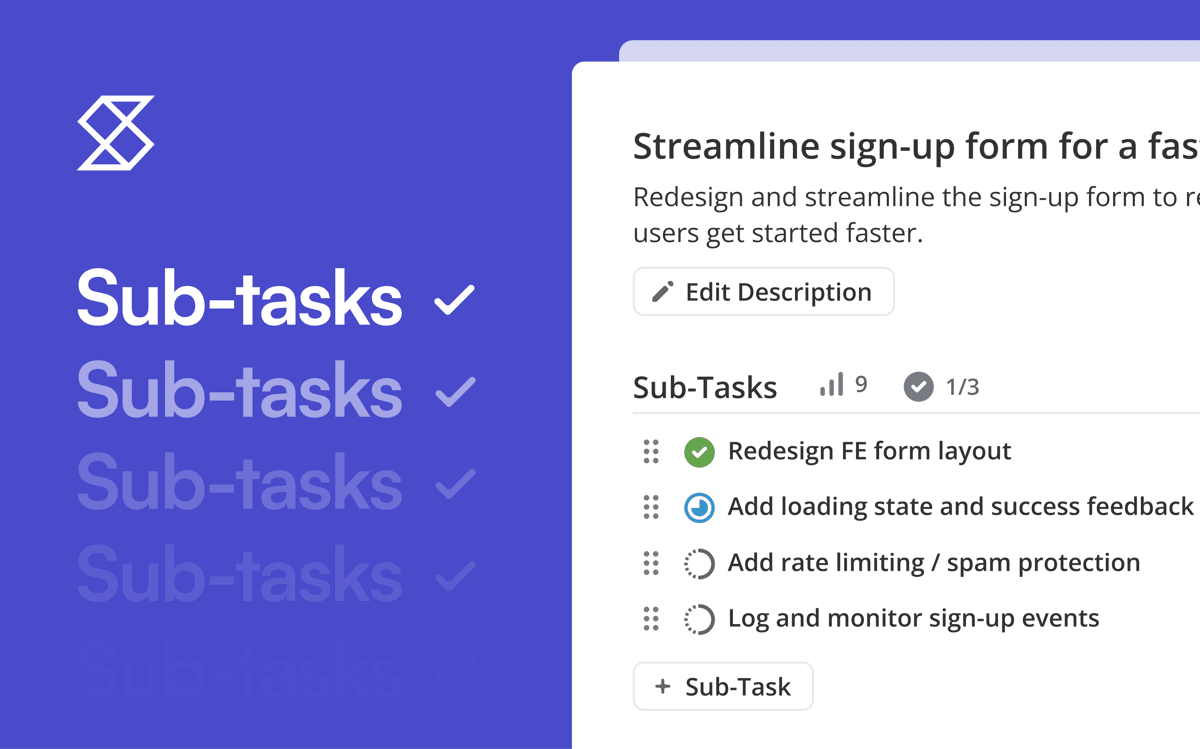Today we're thrilled to roll out Docs to all Shortcut users to help plan, manage, and document work for seamless, frustration-free software development.
We created Docs because we believe that fresh, living documentation updated in real-time is the only kind that provides trustworthy, useful written information when it comes to collaborating and building great products.
It's even better if that useful information is integrated within your software project management tool, synced automatically to exist as a single source of truth. We're confident this is a game-changer for product development.
In Shortcut, a Doc isn't just a normal doc, existing separately in another tool, like a Confluence or Notion. A Doc is part of the Shortcut fabric, and it's linked to Stories, Epics, Milestones, Labels, and more. For example, you can highlight any text in a Doc and create a Story, Epic, Iteration, or a Milestone from that text to be forever synced across Shortcut.
This way, if an engineer updates that Story while they're working on the code, it automatically updates in Docs.
Getting Started with Docs
Docs help teams across an organization to:
Get Context Quickly
It’s hard to jump into discussions and unblock work when you can’t access relevant information. Shortcut makes it easy to provide context and meet people where they want to consume information. Have confidence that what you’re working on is the latest. Any changes you make automatically get synced to the core documentation that others are reading.
Stop Tool Hopping
It’s mentally exhausting to always be switching between tools. Shortcut offers an always in sync, seamless user experience across Docs and work (via one unified UI and consistent information architecture). Docs allow you to put your mental energy towards creativity, not context switching between tools.
Collaborate
Shortcut provides a single source of truth for product development. Shortcut makes it easy to collaborate by unifying and aligning teams across the development and GTM organization.
Merge Processes
Docs supports the rituals and processes you’re already using within the app. The product development lifecycle is enhanced by keeping everything synced within the Shortcut app.
The Shortcut Way
At Shortcut, we aim to be a fully integrated hub for teams to plan, manage, and document their work all through one unified experience, with zero context switching. We built, and continue to build Shortcut for:
- Product people who truly, genuinely care that features are loved by users
- Engineers who want to build things and fix problems, not fiddle with busy work and politics
- Managers who don’t want to micromanage
Below are the core principles of the Shortcut Way. These are simple fundamentals designed to motivate, align, and make teams more productive. Shortcut is built on, and built to support, these practices.
- Structure Your Team So Everyone's Voice is Heard
- Set Goals From the Top and Innovate from the Bottom
- Ideate Collectively
- Plan and Build Continuously in One Tool
- Maintain a Single Source of Truth
- Create a Culture of User Empathy and Experimentation
- Structure Your Work So You Can Ship Iteratively
- Ship Often
- Measure Successes and Celebrate Wins (and Failures)
Read the full Shortcut Way here.
The launch of Docs is a big part of how we’re making it even easier to do things in the Shortcut Way, while still making it possible for teams to customize and innovate around their processes.
Shortcut Docs
Docs seamlessly interacts with Shortcut's issue tracking features, making it simpler to plan, build, and ship new features.
Connect the context to the work
Docs seamlessly connect to the rest of Shortcut, giving your team documented context for ongoing work and making it easier to align and collaborate.
Work lives side by side with your documents - you’ll be able to list Stories and Epics connected to a Doc and see their status directly within that Doc. Our goal is to build something awesome so that you can document what you’re working on at a high level while still tying it back to all of your work-in-progress.

It's never been easier to turn words into work
Jam away in a Doc and whenever you're ready you can highlight the text in a Doc and with a couple of clicks turn it into a Story, Epic, Iteration, or Milestone. Better yet, the entire experience is all in one place so you're not jumping from tool to tool.
It's never been easier to turn words into work

Ideate, collaborate, and align your team with Docs
It's easy to connect a Doc to the work in Shortcut at the Story, Epic, Milestone, and Iteration level so everything stays in sync as work moves forward.
Ideate, collaborate, and align your team with Docs

Bring planning and building together
Product managers spend a lot of time updating various channels and attending meetings. They also put a lot of effort into creating good documentation. But documentation loses its value as soon as it becomes stale, when it becomes divorced from the execution of work, which is constantly evolving. As a PM, you don’t necessarily have time to constantly replicate content across Docs and Stories to keep everything up to date.
PMs use Docs for:
Conversely, as a member of an engineering team, you often want to know: why am I building this? Days, months, or years later you may want to know: why did we decide to build it this way?
Instead of searching across multiple tools (comments within issue tracker tickets, Slack threads, Notion docs, etc.), you want the context in a place that makes sense. You don’t have the time to read through lengthy documents in different tools in order to understand what you’re building and why.
Engineers also want to have confidence that the tickets you’re working on have the latest specs, and that any changes you make automatically get synced to the core documentation that others are reading.
Some ways Docs remedy these common pain points for engineers include:
- Technical Design Doc
- Architecture Decision Record (ADRs)
- Incident Post Mortem
- Squad Daily Standups
- Iteration Planning
Read More: Check out this blog post which explores how to use Docs examples (or templates) to supercharge your Shortcut experience.
What's coming up next in Docs:
We have a lot of exciting things planned next - here's a sneak peek at what we're thinking about next:
Deeper integration between Docs and the rest of the product, such as:
- Docs included in the Activity Feed
- Consistent visibility of Milestones, Epics, and Stories in Docs - Shipped!
- Ability to drill down on Milestones and Epics seamlessly within a Doc - Shipped!
More collaboration in Docs
- Better Notifications
- Enhanced comment experience
- Public Docs! - Shipped
Have other things you want in Docs? Let us know.
At Shortcut, we want to support those who are trying to build great things. The people that actually get things done. We'll keep innovating our Docs functionality, and cannot wait to share more, because want to make it easy for you to ideate, plan, build, and ship great software together as a team - again and again. No other product development tool does it like us.

















%20(788%20x%20492%20px)%20(1).png)
.png)

